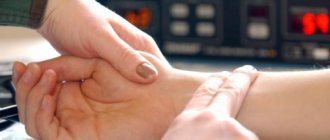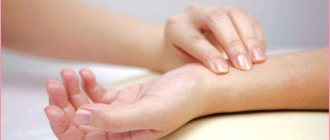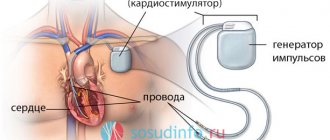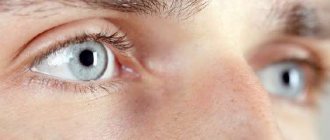Such an important indicator as heart rate allows you to monitor the state of the body during and after physical activity. What should the pulse be during exercise and how to calculate its norm?
During moderate-intensity physical activity, your heart rate should be between 50% and 70% of your maximum.
The maximum heart rate after physical activity is calculated using the formula: 220 minus the person’s age. For example, for a 50-year-old person, the maximum heart rate is: 220 - 50 years old = 170 beats per minute. Now let's determine 50% and 70% of this indicator: 170 x 0.50 = 85 beats per minute, 170 x 0.70 = 119 beats per minute.
Thus, for a 50-year-old person during moderate-intensity physical activity, the heart rate should range from 85 to 119 beats per minute. All values falling within this interval can be considered normal.
During high-intensity physical activity, the heart rate ranges from 70% to 85% of its maximum.
To calculate the maximum frequency, we will use the same formula. Let's determine the maximum age-related heart rate. For example, for a 35-year-old person, the maximum heart rate is 220 – 35 years old = 185 beats per minute. Now let's determine 70% and 85% of this indicator: 185 x 0.70 = 130 beats per minute and 185 x 0.85 = 157 beats per minute.
Thus, during high-intensity activities or immediately after physical activity, the normal heart rate of a 35-year-old person is between 130 and 157 beats per minute.
Heart rate recovery after moderate to high intensity physical activity
The recovery period after high- and moderate-intensity exercise is about 10 minutes. If during this time the heart rate has not returned to normal, you should reduce physical activity.
Other symptoms also indicate excessive exercise. If during physical exercise you feel weak, dizzy, or find it difficult to breathe, the load is excessive, its intensity must be reduced or the exercise should be stopped altogether.
To avoid deterioration of health, and sometimes critical conditions, start physical exercises with light loads and at a slow pace, increase the intensity of exercise gradually. And don’t forget about monitoring your condition during and after physical activity!
Pulse is a rhythmic oscillation of the vascular wall caused by the wave-like flow of blood. The number of shocks is approximately equal to the number of heartbeats. In some pathological conditions, there may be a discrepancy between ps and heart rate (pulse deficiency). The pulse is one of the main markers of the functioning of the human body. Its indicators are not constant and can change under the influence of age and psycho-emotional experiences. Normally, the heart rate increases during physical activity (running, jumping, lifting weights, martial arts), let's look at the heart rate zones for training and calculate the maximum allowable heart rate.
The body of warm-blooded animals is designed in such a way that the intensity of metabolism directly depends on body size. The smaller the creature, the more intense its biochemical processes occur and the faster the heart beats. A person is no exception, so his heart rate changes throughout the entire period of body growth. The older a child gets, the slower his heart beats.
So, the pulse is not a constant value and can change during physical activity. The work of skeletal muscles leads to an acceleration of metabolic processes. In addition, in an organism experiencing stress, the release of adrenaline and other natural vasopressors increases. All this leads to an acceleration of heart rate and increased blood pressure. Soon after the load disappears, heart rate indicators return to normal.
| Category of people (age) | newborns | 3-6 months | 0.5-1 year | 1-10 years | 11 years and above | Prof. athletes |
| Pulse indicators (beats/min) | 100-150 | 90-120 | 80-120 | 70-130 | 60-100 | 40-60 |
Pulse as an indicator of heartbeat: what is important to know?
Measuring your heart rate using a stopwatch while running is an almost impossible task.
And if an athlete is into cardio, then he should purchase a heart rate monitor for jogging outside and use the monitoring devices built into exercise bikes and treadmills. When the goal of cardio is to burn body fat, your heart rate should be between 120 and 150 beats per minute. Bodybuilders should follow a slightly different regimen to preserve muscle. Cardio should be low-intensity, that is, within a session lasting 50-60 minutes, the pulse should be in the 120-130 beats mode.
Experienced athletes do not recommend raising your heart rate to the upper limits. The ideal heart rate is considered to be 120-140 beats per minute, maintained from the beginning to the end of the workout. It is necessary to avoid dropping the heart rate below the lower limit, which is why rest between approaches should not be done for more than a minute.
It is not recommended to lift the barbell at maximum heart rate. You must try to keep it within 130 beats throughout the training. This will strengthen the heart muscle, increasing the effectiveness and efficiency of strength training.
For example, after running?
This indicator is individual and depends on the person’s age, physical fitness and health.
I somehow had to take part in the training of two athletes, a 2-class student and a first-class master.
I took my heart rate and recorded my heart rate readings before the race, immediately after the race, and after a minute of rest. If the first 2 readings differed slightly between them, then the third differed greatly. The KMS-nick's heart rate returned to normal, while the 2-class man's pulse decreased slightly, compared to the measurement after the race.
The total indicator of the load (duration plus intensity) is the heart rate measured 10 and 60 minutes after the end of the session. After 10 minutes, the pulse should not exceed 96 beats per minute, and after 1 hour it should be beats per minute above the initial (pre-working) value. For example, if before the start of the lesson the pulse was 70 beats per minute, then if the load is adequate, 1 hour after the end of the workout it should be no more than 82 beats per minute.
My pulse returns in just over an hour. Age 64 years. The heart is not healthy. From your comment it follows that recovery of heart rate after exercise within 1 hour is the norm? Can you be more specific about the source of your conclusions? - more than a month ago
Such an important indicator as heart rate allows you to monitor the state of the body during and after physical activity. What should the pulse be during exercise and how to calculate its norm?
During moderate-intensity physical activity, your heart rate should be between 50% and 70% of your maximum.
During high-intensity physical activity, the heart rate ranges from 70% to 85% of its maximum.
The recovery period after high- and moderate-intensity exercise is about 10 minutes. If during this time the heart rate has not returned to normal, you should reduce physical activity.
I am 28 years old, 186 cm, 79 kg.
I decided to fight this and signed up for boxing at the gym. After the first lesson (about 2 hours of active training), I came home (it took 15 minutes to walk, 7 minutes, I changed clothes) and measured my blood pressure - 120/75, but my pulse was 115 beats per minute. And he returned to normal within a minute, probably gradually. In the morning I got up and my pulse was also normal. Those. as if this is not overtraining, otherwise the heart rate would be elevated in the morning.
The answer is correct provided that you are healthy.
Sometimes I have arrhythmia, they even put me on Holtem for a day - they didn’t find anything like that and they said it couldn’t be treated. It happens for some reason - after prolonged stress or moral tension, chronic lack of sleep, and for some reason in the doctor’s office when they do a cardiogram, but as soon as you leave the office, everything goes away in a couple of minutes. After physical activity, arrhythmia does not appear for a long time, even during stress and lack of sleep, I conclude that they are useful for me.
I also have VSD, or rather not always, but only when I’m nervous for a long time or in combination with lack of sleep. In general, in other cases I feel completely fine. Now I’m trying to get enough sleep and, if possible, eliminate moral stress. And I don’t feel at all inferior; I lead a completely fulfilling lifestyle.
Roman Pomazanov2
Pulse is a very important informative indicator of a person’s health and fitness. The heart rate will immediately tell you whether the training load is too low, whether you are in a state of overtraining, whether your results from training are increasing, whether you are starting to get sick, etc.
As training increases, resting heart rate decreases. This is due to the growth of the heart’s capabilities and the adaptation of the entire circulatory system. If this does not happen, you need to analyze your training, especially for cardio training and excessive strength training.
The heart rate reaches informative indicators only when the exercise lasts more than 3–5 minutes. During this time, the activity of the cardiovascular system intensifies and fast sources of energy in the muscles are depleted (see the basics of cardio training). That is why during short-term work, for example, when running short distances, performing acyclic exercises (high jumps, long jumps, lifting dumbbells or barbells, etc.), heart rate values may be small or say nothing about the real state of affairs.
Slow recovery or decreased heart rate may indicate excessive physical activity during training or improper planning of this activity. If, in the two minutes of rest between approaches to the barbell, your heart rate has not yet dropped to the beat, then you need to either reduce the weight of the barbell, or do fewer repetitions, or rest more between approaches.
It is conventionally accepted to consider normal a load that causes an increase in heart rate to 120–160 beats/min. Training at a heart rate higher than beats per minute means forcing your heart to work harder. Especially if this pulse is maintained for a long time (5 or more minutes).
A good indicator of fitness is heart rate at rest. A resting pulse of 48–60 beats/min is considered excellent; 60–74 beats/min. - how good; 74–89 beats/min. – as satisfactory; more than 90 beats/min. – as unsatisfactory.
The maximum heart rate per minute allowed for your age can be calculated using the formula: 220 – age = heart rate max
As physical activity increases during training, heart rate increases rapidly in proportion to its intensity. It’s like playing catch-up: the load increases, and the heart tries to keep up with it, which pumps oxygenated blood through our body faster and faster, thus trying to compensate for all the body’s losses. The greater the load and the longer it is, the faster you approach your maximum heart rate.
The maximum heart rate is reached before the moment of extreme fatigue and at the stage of stabilization of the pulse. This is a very reliable indicator that remains constant from day to day and only changes with age, usually decreasing.
It is strictly not recommended to cross the threshold of the maximum heart rate for your age, much less stay in this mode for a long time. The body cannot withstand excessive stress and begins to fail. The first sign that you have crossed the limits of your capabilities is the appearance of shortness of breath, at first slight, then increasingly intensifying, and in the end more reminiscent of suffocation, when you can no longer utter a word.
Such sensations may occur before you have reached your maximum heart rate. Perhaps today you are tired, nervous, did not get enough sleep, feel unwell, or have gone too far at work with the number of cups of strong coffee you have drunk - then your workout should take place in a gentle, calm manner.
Never allow yourself to be drawn into training with such sensations (choking, lack of air, blue face). Yes, you need quite a high intensity to achieve noticeable results. However, you must be prepared by preliminary training for this intensity. A trainer who forces beginners to train this way is an illiterate criminal.
To ensure that your heart rate is always normal and your heart can cope with serious stress, regularly train to develop stroke volume.
When training, always stick to your individual load zones. And you will never have heart problems.
Why does your heart rate increase after exercise? During exercise, blood circulation increases because working muscles need energy. The heart is the main organ that pumps blood through the vessels. The greater the load, the more blood the heart needs to pump, and accordingly, the heart rate increases. If a person does not exercise often, his heart rate will return to normal more slowly than that of a trained person.
To normalize your heart rate, you should restore your breathing. The heart beats faster because more oxygen and adrenaline enter the blood during physical activity. To make the heart beat slower, you need to reduce the supply of oxygen. To do this, a person must breathe less often and deeper, take a deep breath, hold his breath a little and exhale long.
Along with deep breathing, you can slowly walk from side to side. Third method. How to normalize your heart rate without simply doing anything? A healthy person is able to normalize their heart rate within 2-5 minutes after stopping physical activity. To do this, you need to lie down comfortably, relax and close your eyes. The lighter the loads, the faster the pulse normalizes. Fourth method. You need to take a container of cold water and immerse your face in it. After two minutes the pulse returns to normal.
How to determine your individual heart rate zone?
Calculation of the maximum allowable heart rate
During sports activities, especially those aimed at burning fat, an increase in heart rate is necessary. However, the indicator should not exceed the age norm. Monitoring is carried out using heart rate monitors or portable pulse oximeters (for those working with diseases of the respiratory system). Acceptable indicators are determined by the formula:
220 – age in years = MP (Maximum Pulse)
This method is universal, but is not highly accurate. When calculating MP, it is recommended to use specialized algorithms given below:
For men: 214 – (age * 0.8) = MP
For women: 209 – (age*0.9) = MP
If during training your heart rate exceeds the calculated values, it is recommended to reduce the load level or take a break necessary to normalize your heart rate.
Heart rate after warm-up
The second indicator to track is your heart rate immediately after. A good range is considered to be between 100 and 120 beats. If more, you need to reduce the intensity of the preliminary exercises. The main task in this process is to warm up the muscles and simply saturate the blood with oxygen. A higher heart rate will trigger the same processes as strength training or cardio training. As part of the warm-up, you don’t need to push your body and feel tired - this is a serious mistake. You want to warm up, not get tired and burn calories. The first set of strength training or cardio exercise should begin in the heart rate range from 80 to 100 beats.
Heart rate zone chart for training
The level of increase in heart rate during training is conventionally divided into 5 zones, each of which is best suited for achieving a specific goal. The defining indicators of the salary and the tasks for which they are intended are discussed in the table below:
| Name | Target | Athlete's age | Pulse in women | Pulse in men |
| Health-improving | Preparation for sports training, exercise therapy for heart rate diseases | 20 | 114 | 119 |
| 40 | 104 | 109 | ||
| 55 | 96 | 102 | ||
| 70 | 88 | 95 | ||
| Fitness | Fat burning | 20 | 134 | 139 |
| 40 | 121 | 127 | ||
| 55 | 112 | 119 | ||
| 70 | 102 | 111 | ||
| Average activity | Development of physical capabilities | 20 | 153 | 158 |
| 40 | 138 | 146 | ||
| 55 | 128 | 136 | ||
| 70 | 117 | 126 | ||
| Increased load | Development of explosive capabilities, muscle mass of the legs | 20 | 172 | 178 |
| 40 | 156 | 164 | ||
| 55 | 144 | 153 | ||
| 70 | 131 | 142 | ||
| Maximum load | Maximum development. Most often used by professional athletes | 20 | 191 | 198 |
| 40 | 173 | 182 | ||
| 55 | 160 | 170 | ||
| 70 | 146 | 158 |
Cardio
A separate area of training is cardio exercise. They were originally designed to develop the heart muscle and lose excess weight. The optimal indicator for such a load is considered to be a pulse of up to 150 beats per minute under the same type of load (for example, cycling, elliptical or jogging at the same speed). If your heart rate is up to 140 beats per minute, you can increase your running speed or the duration of the same type of workout.
A different approach should be taken for interval loading. Their main essence is alternating the intensity of training. Here you need to alternate the pulse rate. Bring your heart rate to 110 beats per minute before speeding up again. And during peak loads, you can be guided by the maximum heart rate formula used for strength loads (sum 220 - age).
Heart rate recovery after exercise
Pulse recovery after physical activity can take from 2-3 to 20-30 minutes. The optimal indicator is considered to be a 20% decrease in heart rate during the first minute of rest. After 3 minutes, the pulse should decrease by 30%, after 5 minutes - by 50%, after 10 minutes - by 75% of the maximum. For trained people this process proceeds faster, for beginners it takes longer. If recovery takes more than 20 minutes, then the load was selected incorrectly and should be reduced
In order for the functioning of the respiratory and cardiovascular systems to recover smoothly, it is not recommended to stop physical activity immediately. After physical exercise, you should take a few minutes to walk. At the same time, breathing exercises are done. This avoids sudden surges in heart rate and blood pressure.
Is arrhythmia dangerous?
Intensity of exercise that increases the workload of the heart muscle can have negative consequences. If the symptoms of arrhythmia do not disappear within 5-10 minutes, then you should visit a cardiologist.
The danger of arrhythmia depends on which type of arrhythmia manifests itself subsequently after physical activity.
Sinus arrhythmia and tachycardia often do not require treatment, but they can sometimes indicate the presence of other more serious diseases. Sinus bradycardia is dangerous because the consequence of a slow heart rate can be fainting, and in such cases the likelihood of cardiac arrest increases.
If atrial fibrillation and treatment is not carried out, blood clots may occur. Paroxysmal tachycardia threatens the human body with wear and tear of the muscles of the main organ due to its improper functioning. Extrasystole poses a threat to health in the presence of diseases such as myocarditis, coronary artery disease, and valve disease.
In general, the consequences of arrhythmia can manifest themselves as follows:
- The formation of blood clots as a result of unstable heart function, which causes stagnation of blood in the vessels.
- Heart failure is a consequence of untreated arrhythmia, which causes swelling of the arms, legs and shortness of breath.
- Kidney failure is a high probability of developing this disease in case of any malfunction of the heart.
- A stroke is a consequence of thrombus formation, in which detached blood clots can reach the brain vessels and cause an attack.
- Arrhythmogenic shock occurs with ventricular fibrillation.
- Cardiac arrest is a very dangerous consequence of arrhythmia, in which the heart stops beating and clinical death occurs.
Read also: Systolic tachycardia
Athletes' heart rate
A constant change in heart rate is observed in professional athletes and amateur athletes with extensive training experience. The leading position here is occupied by weightlifters: bodybuilders, powerlifters, weightlifters. The normal heart rate for such people is considered to be 40-60 beats per minute. This is due to the thickening of the walls of the heart and its more powerful contractions. To pump blood throughout the body, such an organ does not require a large number of contractions. It copes with its function by increasing the force and volume of ejection.
Pulse is an important indicator of the body's performance during physical training. Based on its values, you can evaluate how well the body copes with the task assigned to it, how correctly the load is selected, and whether the training is effective. Therefore, all people who regularly engage in sports are recommended to use a portable heart rate monitor bracelet.
Patients at appointments are often interested in what physical activity is safe and beneficial for their heart. Most often this question arises before the first visit to the gym. There are many parameters for controlling maximum load, but one of the most informative is heart rate. Its calculation determines the heart rate (HR).
Why is it important to control your heart rate during exercise? To better understand this, I will first try to clearly explain the physiological basis of adaptation of the cardiovascular system to physical activity.
Factors affecting heart rate
Physical training, weight lifting, swimming and other types of exercise require an individual approach. It is necessary to determine the intensity of exercise according to indicators such as breathing rate, blood pressure and pulse. It is especially important to pay attention to heart rate. In case of abnormal indicators, tachycardia, bradycardia, and unstable arrhythmia can be diagnosed. On average, the pulsation rate should be in the range of 60 – 90 beats per minute. Deviations are allowed. The frequency of muscle contractions depends on a number of factors:
- Age (in older patients the heart beats faster);
- Gender (the male body requires more resources);
- Height (the greater the height, the more muscle mass, which means the need for metabolic processes is higher, which causes the heart to contract more often);
- Weight (exceeding weight norms leads to the formation of atherosclerotic plaques on the walls of blood vessels, and subsequently there is fat on the heart, which significantly impairs the functioning of the organ);
- Health (if a person is constantly sick, then his body works in an enhanced mode);
- Psycho-emotional state (irritable people who are exposed to frequent stress, prone to depression and neuroses often notice heart palpitations after exercise);
- Bad habits and poor lifestyle lead to rapid pulsation.
The above factors force the heart to pump blood more and more often in order to provide all organs with nutrients and remove waste products. If any of them are present, you will experience a rapid heart rate with light exertion.
Cardiovascular system during exercise
Against the backdrop of stress, the tissue's need for oxygen increases. Hypoxia (lack of oxygen) serves as a signal to the body that it needs to increase the activity of the cardiovascular system. The main task of the cardiovascular system is to ensure that the supply of oxygen to the tissues covers its costs.
The heart is a muscular organ that performs a pumping function. The more actively and efficiently it pumps blood, the better the organs and tissues are provided with oxygen. The first way to increase blood flow is to speed up the heart. The higher the heart rate, the greater the volume of blood it can “pump” in a certain period of time.
The second way to adapt to stress is to increase stroke volume (the amount of blood released into the vessels per heartbeat). That is, improving the “quality” of the heart: the larger the volume of the heart chambers occupied by blood, the higher the contractility of the myocardium. Due to this, the heart begins to pump out more blood. This phenomenon is called the Frank-Starling law.
Heart rate calculation for different load zones
As your heart rate increases during exercise, your body undergoes various physiological changes. Heart rate calculations for different heart rate zones in sports training are based on this feature. Each zone corresponds to a percentage of heart rate from the maximum possible rate. They are chosen depending on the desired purpose. Types of intensity zones:
- Therapeutic zone. Heart rate – 50-60% of maximum. Used to strengthen the cardiovascular system.
- Heart rate zone for fat burning. 60-70%. Fighting excess weight.
- Strength endurance zone. 70-80%. Increased resistance to intense physical activity.
- Improvement zone (hard). 80-90%. Increasing anaerobic endurance - the ability to perform long-term physical activity when the body's oxygen consumption is higher than its supply. Only for experienced athletes.
- Improvement zone (maximum). 90-100%. Development of sprint speed.
To safely train the cardiovascular system, use pulse zone No. 1.
How to correctly calculate the optimal load?
1. First find the maximum heart rate (HRmax), for this:
Re: Tachycardia and stress during training
There are few contraindications to exercise in pulse zone No. 1. They are determined individually. Main restrictions:
- Hypertonic disease. The danger is posed by sudden “jumps” in blood pressure. Cardio training for hypertension can be carried out only after proper correction of blood pressure.
- Coronary heart disease (myocardial infarction, angina pectoris). All loads are performed outside the acute period and only with the permission of the attending physician. Physical rehabilitation in patients with coronary artery disease has its own characteristics and deserves a separate article.
- Inflammatory heart diseases. Under a complete ban on exercise in case of endocarditis, myocarditis. Cardio training can only be done after recovery.
Tachycardia during physical activity is not just an unreasonable acceleration of heart rate. This is a complex set of adaptive physiological mechanisms. Heart rate control is the basis of competent and safe training of the cardiovascular system. For timely load correction and the ability to evaluate the results of cardiovascular training, I recommend keeping a diary of heart rate and blood pressure.
But such figures are traced very rarely; for the most part, all people have minor deviations from these indicators. At the same time, there are no visible signs of problems in the body.
It is for this reason that this blood pressure is called “working”. Throughout the day it can fluctuate from one value to another. Stress, neuroses, conflict or physical activity can have a significant impact on it.
If during sports the level of pressure increases significantly, then this is not a pathology, but, on the contrary, is considered a completely acceptable phenomenon. Usually the indicators return to normal within a few hours.
However, there is another side of the coin, which relates to those situations when blood pressure increases to critical levels and remains at this level for a certain period of time. In connection with this situation, it is necessary to understand which numbers are considered acceptable and which are not. From the information in this article you can find out what your blood pressure should be after exercise.
To reduce blood pressure while preserving blood vessels, it is better to add it to tea in the morning before breakfast.
What pressure should be during physical activity depends on gender and age:
- male -/79-84 mm Hg. Art.;
- female years -/78-86 mm Hg. Art.;
- the mark on the tonometer is 141/90 mmHg. Art. is considered borderline because it indicates the development of hypertension.
During exercise in the gym, blood pressure can increase by about 19 mmHg. Art.
In the presence of arterial hypertension, the indicators may be as follows: /91-98 mmHg. Art. With these figures, you can play sports only with the permission of your doctor.
It is very important to give the body a break from exhausting physical activity. The greater the intensity during training, the longer you should rest after it. Some experts recommend keeping a diary, which includes your exercise and rest schedule, as well as your blood pressure levels before and after physical activity.
Rest time is approximately 24 to 48 hours, depending on the difficulty of the workout.
The acceptable heart rate is about 76 beats per minute two hours after physical activity.
To reduce it, you need to slowly inhale and exhale in a position with your hands resting on your knees.
Using this method, you can reduce the pressure level by about 20 beats per minute. There is another option, for which to be effective, you should straighten up, put your hands behind your head and start breathing calmly.
It will help you recover as quickly as possible after cardio or strength training. But, nevertheless, this method is not as effective as the previous one. Although it will also allow you to catch your breath as quickly as possible.
When physical work is replaced by rest, reverse changes occur in the activity of the functional systems of the body that ensured the fulfillment of the load, that is, restoration of performance. During the recovery period, metabolic products are removed from the body and energy reserves and plastic substances (proteins, carbohydrates, etc.) are replenished.
) and enzymes consumed during muscle activity. In essence, the body’s equilibrium state, disturbed by work, is restored. However, recovery is not only the process of returning the body to its previous state. During this period, changes also occur that provide an increase in the functional capabilities of the body.
Rest intervals between classes depend on the size of the training load. They must ensure full restoration of performance to at least the original
level or, at best, until the super-recovery phase. Training in the phase of incomplete recovery is unacceptable, since the body's adaptive capabilities are limited.
The longer the duration of the training load at the appropriate intensity, the longer the rest intervals should be. Thus, the recovery time for basic body functions after a short anaerobic workout is only a few minutes, and after prolonged low-intensity work, for example, after a marathon, it takes several days.
It is known that the optimal dosage of the training load is one of the criteria for the effectiveness of fitness classes. In addition to special tests that allow you to determine your level of physical fitness and select the appropriate load, there are other ways to regularly monitor your muscle condition.
After 10 minutes, the pulse should not exceed 96 beats per minute, and after 1 hour it should be beats per minute higher than the initial (pre-working) value. For example, if before the start of the lesson your heart rate was 70 beats per minute, then in case of adequate load, 1 hour after the end of the workout it should be no more than 82 beats per minute. If within several hours after training the heart rate values are significantly higher than the initial ones, this indicates excessive load.
Objective data reflecting the total magnitude of the training effect on the body (for a weekly and monthly training cycle) and the degree of recovery can be obtained by daily counting the pulse in the morning after sleeping in a lying position. If its changes are in the range of 2-4 beats per minute, this indicates good tolerance to stress and complete recovery of the body. If the difference in pulse zones is greater than this value, you begin to become overtired.
Equally important for self-control of fatigue are subjective indicators of the state of your body - sleep, well-being, mood, desire to exercise.
If you sleep soundly, are in a good mood and have high performance during the day, the training load is adequate for you. If, on the contrary, you complain of poor sleep, lethargy and drowsiness in the morning, you have no desire to exercise - this is a sure sign of overwork. If appropriate measures are not taken and the load is not reduced, more serious symptoms of trouble may appear - pain in the heart, rhythm disturbances, increased blood pressure, etc.
In this case, you should stop exercising for a couple of weeks or reduce the load to a minimum. After these problems disappear, you can start training again and gradually increase the load to normal values.
The reversibility of training effects is manifested in the fact that the accumulated results of regular exercises decrease until they disappear completely (return to the original level) with a decrease in training loads or with a complete cessation of exercises.
After resuming training, positive training effects reappear after some time. In people who systematically engage in physical education, a noticeable decrease in performance is observed after two weeks of stopping classes, and after 3-8 months the level of physical fitness decreases to the pre-training level. This process occurs especially quickly in the first period after stopping training or after a sharp reduction in training loads.
Over the first 1-3 months, the functional indicators achieved as a result of previous training are halved. In people who have recently started training, most of the positive training effects disappear after 1-2 months of rest.
Therefore, if you want to be in shape, regular training sessions with sufficient intensity are a must!
BMI = WEIGHT (kg): HEIGHT (m2)
BMI 18.5 - 24.9 - you have a normal weight.
BMI 25.0 - 29.9 - you are overweight. It wouldn't hurt to lose weight.
Traditionally, weight loss methods are essentially nothing more than limiting calorie intake. Unfortunately, there is no more effective option for losing weight.
Therefore, we have only one thing left to do - learn to lose weight by reducing the calorie content of food, but do this without harming your health.
Sports Science and Medicine Forum
Denis Viktorovich KRYAZHEV, sports medicine doctor, graduate student of the Federal State Center “Heart, Blood and Endocrinology named after. V.A. Almazova”, head of the rehabilitation department of the clinic of sports traumatology and arthroscopy, prof. Kuznetsova I.A. "SportClinic", St. Petersburg.
08 Sep 2012, 17:52
The ECG showed left ventricular hypertrophy, but the ultrasound of the heart was good.
In 2010, I began to engage in physical development. Even after 10 push-ups I was out of breath. But I continued anyway and gradually my heart became more resilient. I began to feel normal on the horizontal bar, on the uneven bars, and in general on any exercises with my own weight. There was no longer any suffocation or pressure in my chest. And although the pulse was high, it was not felt. I forgot about cardiologists.
During subsequent training sessions it was even easier to breathe.
And how to recover more effectively after training, out of habit, your throat hurts and your general health feels like a cold. Garlic and honey are not taken. It seems like I haven’t caught a cold anywhere.
Influence of physiological characteristics
Heart rate in children is initially higher than in adults. So, for a 2-year-old child in a calm state, a pulse of 115 beats per minute is considered the absolute norm. During physical activity in children, unlike adults, stroke volume (the amount of blood ejected by the heart into the vessels in one contraction), pulse and blood pressure increase more strongly. The younger the child, the more the pulse accelerates even with a slight load. In this case, the OP changes little. Closer to 13-15 years, heart rate indicators become similar to adults. Over time, stroke volume becomes larger.
Elderly people also have their own characteristics of heart rate readings during exercise. The deterioration of adaptive abilities is largely due to sclerotic changes in the blood vessels. Due to the fact that they become less elastic, peripheral vascular resistance increases. Unlike young people, both systolic and diastolic blood pressure are more likely to increase in old people. The contractility of the heart becomes smaller over time, so adaptation to the load occurs mainly due to an increase in heart rate, rather than stroke volume.
There are adaptation differences depending on gender. In men, blood flow improves to a greater extent due to an increase in stroke volume and to a lesser extent due to an acceleration of heart rate. For this reason, the pulse in men is usually slightly lower (6-8 beats/min) than in women.
A person who is professionally involved in sports has significantly developed adaptive mechanisms. Bradycardia at rest is normal for him. The pulse can be below not only 60, but also 40-50 beats/min.
Why are athletes comfortable with such a heart rate? Because their stroke volume increased during training. During physical activity, an athlete’s heart contracts much more efficiently than that of an untrained person.
Causes
The human heart works continuously throughout life, but in a calm state it can beat at a frequency of 60-90 beats per minute, and if a person feels anxious or actively exercises, it can increase to 150. This phenomenon is considered normal if after a few minutes the heartbeat comes back to normal.
Read also: Folk remedy for tachycardia
The work of the heart consists of two phases - systole and diastole. During the first phase, it contracts, providing blood flow and supplying oxygen and nutrients to the body; during the second, it rests. If one of the phases for some reason becomes smaller, this threatens the appearance of interruptions in the functioning of the heart, since it either will not have time to supply everything the body needs, or will not be able to fully rest. All these factors can cause arrhythmia.
Arrhythmia is the appearance of disturbances in cardiac functionality, in which the heart rate changes. It appears when the conduction system, which is responsible for ensuring regular contractions of the myocardium, fails. The rhythm in this system is provided by tissue nerve cells collected in nodules, which regenerate and conduct cardiac impulses to the myocardium. Under the influence of an impulse, it contracts (systole) and relaxes (diastole). When impulse transmission is disrupted, arrhythmia occurs.
How does pressure change under load?
Another parameter that changes in response to physical activity is blood pressure. Systolic blood pressure is the pressure experienced by the walls of blood vessels at the moment of heart contraction (systole). Diastolic blood pressure is the same indicator, but during myocardial relaxation (diastole).
An increase in systolic blood pressure is the body's response to an increase in stroke volume provoked by physical activity. Normally, systolic blood pressure increases moderately, up to 15-30% (15-30 mmHg).
Diastolic blood pressure also changes. In a healthy person, during physical activity it can decrease by 10-15% from the original (on average, by 5-15 mmHg). This is caused by a decrease in peripheral vascular resistance: in order to increase the supply of oxygen to tissues, blood vessels begin to dilate. But more often, fluctuations in diastolic blood pressure are either absent or insignificant.
Why is it important to remember this? To avoid false diagnosis. For example: blood pressure 140/85 mmHg. immediately after intense physical activity is not a symptom of hypertension. In a healthy person, blood pressure and pulse return to normal fairly quickly after exercise. This usually takes 2-4 minutes (depending on training level). Therefore, for reliability, blood pressure and pulse must be rechecked at rest and after rest.
Diseases
After training or increased physical activity, even a healthy person will experience tachycardia. But it is necessary to distinguish when an illness is a temporary result of activity, and in which cases it indicates deviations. A disease is considered if:
- tachycardia is observed for a long time, and the pulse is above 120 beats per minute;
- if the heart rate is slow during and after training, then bradycardia is diagnosed;
- If the heartbeat is irregular, a diagnosis of cardiac arrhythmia is made.
Please note: Slow heartbeat is present in professional athletes. The fact is that their body gets used to increased stress, and the heart muscle is able to pump the required volume of blood in fewer contractions. This is an absolutely normal process.
Optimal performance
When muscles contract, the heart pumps blood through the arteries. The impulses arising as a result of this process are felt by a person in the form of a pulse. Intensity is determined by the number of heart beats per unit of time. In a normally functioning body, the norm is 60-80 beats per minute.
Heart rate depends on many factors:
- age;
- Height Weight;
- endurance of the body, degree of adaptation to physical activity;
- functional indicators of the body;
- presence of chronic diseases;
- psycho - emotional state of a person;
- Times of Day;
- eating, alcohol.
It is important to be able to calculate individual heart rate limits, which will help maintain good health and a healthy state of the body. There is a special formula: 220 – person’s age = normal heart rate. To have a beautiful body, subcutaneous fat must be burned during exercise. The intensity of an effective workout should not be higher than 60-70%.
Pulse rate indicators in a person who does not have health problems cannot be called reliable in the following cases:
- period of fatigue, after heavy physical and mental activity;
- after taking medications, food, alcoholic beverages;
- water treatments, relaxing bath, massage;
- exposure to heat or extreme cold;
- active physical activity;
- being in close proximity to a fireplace or fire;
- insomnia, overwork, stress;
- in women with menstrual bleeding.
Since the degree of intensity depends on the tone and pressure in the blood vessels, it increases during physical activity. If a person is adapted to physical activity, regularly plays sports, and is trained, his resting heart rate, as a rule, is lower. In order to properly monitor, it is necessary to measure the frequency of contractions of the heart muscle immediately before exercise. You can determine the optimal age zone of the heart rate, which depends on the intensity of movement.
Stress
But in addition to sports, you need to measure your heart rate under the influence of various external factors, and especially stress. It is not without reason that the pulse is one of the key indicators on which the science of detecting lies is currently based. The principle of operation of a polygraph in a simplified form is reading a person’s pulse, since deception most often implies excitement and, as a result, an increase in heart rate. This knowledge is also widely used by professionals in games where bluffing is involved - an increased heart rate, shaking hands and beads of sweat on the opponent's face are important clues about his cards. Therefore, if your heart rate has changed recently, it is quite possible that the reason for this is not physical activity at all. Pay attention to whether you have recently had strong emotional experiences or prolonged stress.
Tips for controlling your heart rate for a healthy person are as simple as possible - watch your diet and exercise your heart regularly. More physical activity and constant walks in the fresh air are an excellent prevention of cardiovascular diseases.
Giving up bad habits, a balanced diet, and regular visits to the gym have become a real fashion trend today. An increasing number of people of different ages are choosing a healthy lifestyle, including regular physical activity. In order for sports to bring only benefits, it is necessary to eliminate the risk of injury when performing exercises. Sports instructors strongly advise you to closely monitor your training technique and choose the optimal activity. It is important to monitor your heart rate during physical activity. As the body adapts and gains endurance, the intensity increases. Correct determination and control of the intensity of individual physical activity is the key to health and successful sports activities.
Any training has its own standards for the physical state of the body, thanks to which you can regulate the intensity of sports activities:
- pressure;
- breathing rate;
- pulse.
The last parameter is given special attention. For a particular age group, there are individual parameters for the frequency of contractions of the heart muscle, exceeding which is fraught with health problems.











